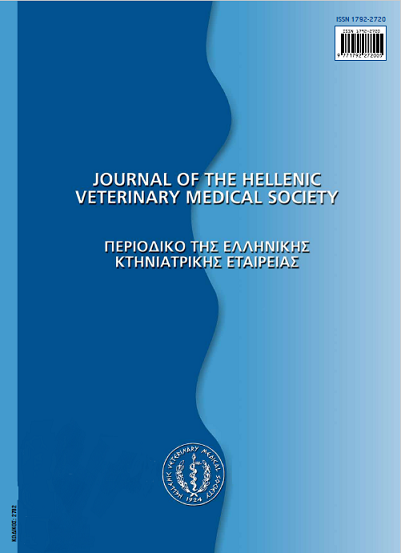Welfare parameters in dairy cows reared in tie-stall and open-stall farming systems: pilot study
Аннотация
Animals can experience pain or distress as a result of widely accepted management practices. In dairy cattle, housing system can affect animal welfare. The assessment of animal welfare requires the use of multiple indicators in order to analyse the heterogeneity of the aspects involved. The aim of this study was to compare the welfare of dairy cows reared in a tie-stall (TS) and open-stall (OS) system by metabolic, immunological and stress related parameters. The study involved 80 pluriparous lactating cows belonging to eight dairy farms located in the area of Mugello (Florence, Italy) reared in TS and OS systems. Ten blood samples were collected at morning time to measure alanine-aminotransferase (ALT), aspartate-aminotransferase (AST), blood urea nitrogen (BUN), β-hydroxybutyrate (BHBA), creatinine (Creat), non-esterified fatty acids (NEFA), total proteins (TP), calcium (Ca), phosphorus (P), and potassium (K), serum lisozyme (SL), bactericidal activity (SBA), haptoglobin (Hp), oxygen free radicals (OFR), and hair cortisol levels. At the same time a body condition score (BCS) was recorded. Statistical analysis was performed by ANOVA. The experiment was carried out in accordance with European Commission regulations (Directive 2010/63/EC and Directive 98/58/EC). The results showed that the housing system affected various parameters such as ALT, BHBA, OFR, cortisol (P≤0.01) and AST, BUN (P≤0.05). Most of these parameters showed mean values within the range of reference without revealing any signs of suffering. An interesting outcome regarded the OFR levels, which was higher in the OS system (68.2±34.51 U.Carr. vs 36.1±21.39 U.Carr.), probably as a consequence of the high productive effort. In conclusion, it is possible to state that TS did not show a comparable overall situation with serious signs of welfare impairment.
Article Details
- Как цитировать
-
BENVENUTI, M. N., GIULIOTTI, L., LOTTI, C., ACCORSI, P. A., PETRULLI, C. A., & MARTINI, A. (2018). Welfare parameters in dairy cows reared in tie-stall and open-stall farming systems: pilot study. Journal of the Hellenic Veterinary Medical Society, 69(1), 809–814. https://doi.org/10.12681/jhvms.16430
- Выпуск
- Том 69 № 1 (2018)
- Раздел
- Research Articles

Это произведение доступно по лицензии Creative Commons «Attribution-NonCommercial» («Атрибуция — Некоммерческое использование») 4.0 Всемирная.
Authors who publish with this journal agree to the following terms:
· Authors retain copyright and grant the journal right of first publication with the work simultaneously licensed under a Creative Commons Attribution Non-Commercial License that allows others to share the work with an acknowledgement of the work's authorship and initial publication in this journal.
· Authors are able to enter into separate, additional contractual arrangements for the non-exclusive distribution of the journal's published version of the work (e.g. post it to an institutional repository or publish it in a book), with an acknowledgement of its initial publication in this journal.
· Authors are permitted and encouraged to post their work online (preferably in institutional repositories or on their website) prior to and during the submission process, as it can lead to productive exchanges, as well as earlier and greater citation of published work.



